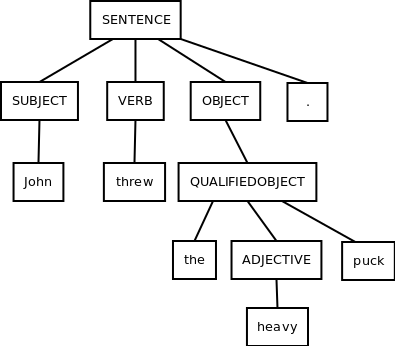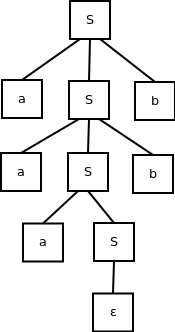Example
Example
Let's say we are examining the language specified by the following context-free grammar:
SENTENCE → SUBJECT VERB OBJECT.
SUBJECT → John | Jane
VERB → threw | kicked
OBJECT → DIRECTOBJECT | QUALIFIEDOBJECT
DIRECTOBJECT → the ball | the puck
QUALIFIEDOBJECT → the ADJECTIVE ball | the ADJECTIVE puck
ADJECTIVE → big | heavy
Example derivation:
Based on this, we know that the sentence "John threw the heavy puck." is part of our language. But what does it mean?
The following parse tree represents our string derivation:

We can learn the following from seeing a parse tree for a string (without requiring any external information):
- We know that our string is part of our language from the presence of the parse tree
- We can determine what the input string is by reading the terminal nodes from the tree
- A simple left-to-right read of the nodes with no children produces the input string - in this case, "John threw the heavy puck."
- We can determine the productions used to derive our string by reading the nonterminal nodes from the tree and observing their direct child nodes
- For example, we can tell that the production "SENTENCE → SUBJECT VERB OBJECT." is used in this derivation by observing the top nonterminal node and its children
- We can determine, structurally, what conceptual part of the language structure a nonterminal, terminal or ε node belongs to
- For example, we know that the terminal "puck" belongs to a qualified object and that the terminal "heavy" is an adjective that belong to a qualified object
